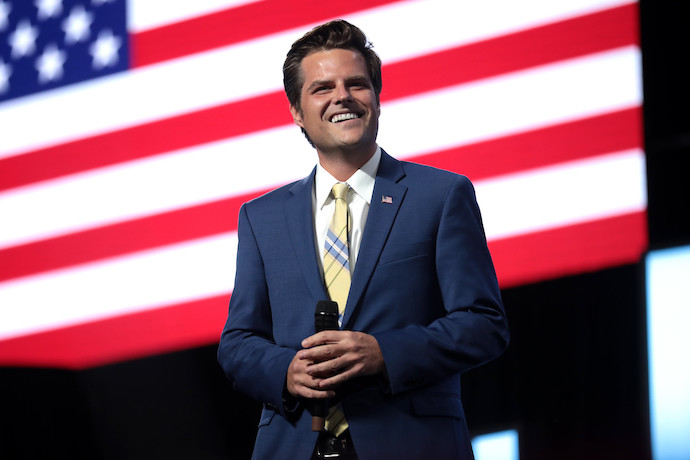Within hours of the storming of the Capitol on January 6, the Republican House Rep and Trump ally Matt Gaetz gave a speech in the House chamber. This is the same chamber that had been under siege by a crowd Trump had himself urged to “show strength” and march on the Capitol, even promising, “I’ll be with you” (incidentally, he drove the opposite direction in his motorcade). Just like the MAGA fest outside the Capitol, the looters who broke in were proudly sporting Trump symbols, carrying Confederate flags, and posting joyfully about overthrowing our elected government on their own social media.
Even in the Civil War, the Confederate flag never got close the Capitol. More than 150 years later, the sight of a man casually carrying one outside the Senate floor was a piercing reminder of the persistence of white supremacism.https://t.co/l2fW7HHBOn
— The New York Times (@nytimes) January 9, 2021
So what was Gaetz’s message shortly after a human had been beaten to death with a fire extinguisher outside the chamber? He first activated conservative fantasies about “the #BLM and left-wing rioters … this summer when we saw violence sweep across this nation,” to the applause of a group of his GOP colleagues. Then Gaetz falsely claimed some of the violent rioters “were masquerading as Trump supporters. And in fact, they were members of the violent terrorist group, Antifa.” His fantasy climaxed in the same lies about election fraud that had inflamed these very Trump supporters for months in the first place.
Matt Gaetz is far from alone among the curators of conservative reality. Mo Brooks struck at the #FakeNewsMedia before offering his own fake news: “Evidence growing that fascist ANTIFA orchestrated Capitol attack with clever mob control tactics.” Elsewhere on the carousel of elected officials, Texas Attorney General Ken Paxton approvingly shared a tweet, “at least 1 ‘bus load’ of Antifa thugs infiltrated peaceful Trump demonstrators.”
Conservative media influencers like Charlie Kirk eagerly amplified, while Sarah Palin declared on Fox News, “A lot of it is the antifa folks.” High priests of White evangelicals were not to be left out; Eric Metaxas began waving his retweeting wand to magically transform Trump supporters into heroes “pulling Antifa terrorists away from the building,” and Franklin Graham pronounced, “most likely it was antifa.”
It’s important to reflect on this immediate outburst from Trump conservatives to blame Antifa or #BLM for their own supporters’ violent White Supremacist tantrum at the Capitol. Thinking of the TrumperTantrum as White Supremacist isn’t to claim that all people there were overt White Supremacists in their beliefs. Presumably many were not, even if they happily marched among Confederate flags or horrific “Camp Auschwitz” and “6MWE” (i.e. 6 million wasn’t enough) shirts.
As Adam Serwer explains, the storming of Congress and the lies that incited it were themselves an attack on multiracial democracy. The narratives underlying the “rigged election” conspiracies ultimately function to invalidate Black political (and economic) power while cultivating a sense of White victimization, all to the benefit of a small group of ruling class whites—as historian Manisha Sinha explains while discussing Heather Cox Richardson’s fascinating book, How the South Won the Civil War.
Serwer’s piece aligns with the way many scholars and public commentators discuss White Supremacy now. The terminology is a provocative way to focus on how society is a place in which whites benefit from the exploitation of BIPOC. It also attends to the—often conservative—narratives that make this status-quo seem so natural to most whites that we don’t notice it. And far from asserting equality among whites, the idea of White Supremacy emphasizes how wealthy whites benefit from working- and middle-class whites identifying with them, often against their own economic interests.
So, apart from simply failing to take responsibility for their followers’ actions, how does blaming Antifa or BLM for the violence at the Capitol fit into all of this?
There’s a long history in the United States of leaders who are aligned with or benefit from White Supremacy exhibiting a very specific behavior. When their own people are caught doing violent things—especially actions they facilitated or incited—they blame the people who oppose them.
My students are always stunned after they read Dr. Carol Anderson’s “Reconstructing Reconstruction” chapter in her indispensable 2016 book White Rage. They learn, often for the first time, that after the American Civil War and then toward the end of Reconstruction, there was a reign of murderous terror by White Supremacists (e.g., the KKK) against Black people who wanted to vote, hold office, and support themselves. The point of this violence was to reestablish overt White Supremacy and, eventually, to end Reconstruction so that Black people could be disenfranchised and subjugated again (to get a quick sense, Google “Black Codes”).
White Supremacist leaders developed a predictable chorus as a PR strategy: the violence was a justified Southern white defense of their liberty against the aggressions of greedy “carpetbaggers” from the North and corrupt Blacks who ruled in the South. These outside agitators were the real instigators and had disrupted otherwise peaceful race relations since “slavery at the South was the gentlest and most beneficent servitude mankind has ever known” (Julian Carr, NC Confederate veteran and KKK supporter).
As historian Adam Domby explains in his excellent book, The False Cause, false stories of happy slaves and unity among Southern whites coordinated with false myths of a tyrannically corrupt Reconstruction to justify the orgy of violence that ended Reconstruction and disenfranchised Blacks all over again.
During the Civil Rights Movement, the national media sometimes picked up on lynchings, the murder or beating of Civil Rights workers, and the bombing of Black churches. According to White Supremacist leaders, it was never the fault of White Supremacists in the South! No, as Mississippi governor Ross Barnett explained, “we in Mississippi” were living “peacefully together” while the violence was from “a group of outside agitators trying to stir up strife and trying to stir up turmoil among our people for absolutely no good cause whatsoever.”
The brutal segregationist regime of terror, economic domination, and disenfranchisement that was Jim Crow vanishes. In the White Supremacist imagination, ending Jim Crow is thus “no good cause whatsoever” since the real source of violence was outside agitation—whether from college students supposedly sent by Jews or the NAACP as aggressors to stir up trouble, or the Federal government’s interference to end segregation. Thus Barnett could declare in a Mississippi football stadium full of whites holding Confederate flags: “There is no case in history where the Caucasian race has survived social integration. We will not drink from the cup of genocide.” To Barnett, whites were the real victims of violent genocidal plans.
So if we go by history, just as disgraced politicians give “I’ve let my family and country down” speeches, so leaders who benefit from White Supremacy do not accept responsibility. They instead blame White Supremacy’s opponents and victims.
There’s a telling overlap here between the politics of White Supremacy and how conservative performances of “masculinity” work, which Kristin Kobes Du Mez, a historian of religion and gender in America, clarifies in her book, Jesus and John Wayne: proclaim the ideals of strength and personal responsibility while, in reality, never taking responsibility but instead complaining about perceived grievances and blaming your victims.
Blaming the victims and opponents of White Supremacy is as American a political tradition as it gets. We simply do not “remember” it as such because that’s part of the magic of White Supremacy: it gets to erase itself. Something like the #TrumperTantrum at the Capitol, though striking in its specifics, then appears to most observers like an unprecedented outrage. Its violence does not seem connected to the violence and political disenfranchisement through which White Supremacy maintains itself.
Spend a moment reading about the Wilmington Insurrection of 1898. A group of two thousand white conservatives led a coup that ousted a legally elected “Fusionist” (i.e., Black and White) government, drove it out of town, destroyed Black businesses (i.e., the wealth and job-creating abilities Blacks had developed), and massacred dozens of Black people. They even published a “White Declaration of Independence” in which they declared “that we will no longer be ruled, and will never again be ruled, by men of African origin … an inferior race.” Overall this declaration rewrites (lies about) history to cultivate a sense of White victimization and Black / Fusionist illegitimacy that justifies a brutal refusal to accept the results of a legal election. Sound familiar?
The insurrection worked so well that we either don’t know about it or we remember it as a “race riot,” which, in the imaginations of most whites today, falsely conjures images of scary Black people rioting. It was the same in the years following the Wilmington massacre: conservative proponents of the white-dominated racial hierarchy “remembered” a riot instigated by Blacks and then put down by the White Supremacist mayor (the one installed by the coup) who “restored sobriety and peace.” Again: White Supremacist leaders decline responsibility for their murderous violence, instead blaming their opponents..
As historian Peggy Pascoe argues, such “forgetting” of the violence, domination, and exploitation of Black bodies that was required to impose White Supremacy is a crucial tool in its continuing maintenance. Racialized forgetting is the precondition for Gaetz, Palin, Metaxas, and Graham to almost reflexively assert BLM and Antifa’s responsibility for the violence at the Capitol once it was established as bad violence in conservative media. There’s a double forgetting at play: a forgetting of the American tradition of violent White Supremacy and a forgetting of—as historian Kellie Carter Jackson argues—the long tradition of Black violence in the service of freedom (i.e., emancipation). Instead what gets remembered in our society is imaginary violence that victimizes innocent whites.
This stuff matters! When it’s the norm that White Supremacy gets to excuse itself from responsibility and even blame those trying to dismantle it, leaders who benefit from or facilitate White Supremacy do not lose their power. They don’t even have to answer tough questions. Instead they can cast themselves as the real victims and heroes. They can, like Matt Gaetz, seamlessly transition from excusing themselves from responsibility to regurgitating the same baseless conspiracies that fomented White Supremacist violence in the first place.
I want the United States to be the place of freedom and hope that our leaders and major media personalities extolled on the evening of January 6! They repeated the chorus of, “This is not who we are.” But as retired NFL player Damien Woody powerfully communicated on FirstTake the morning after the insurrection when he walked viewers through the history of racial violence from Reconstruction to the vilifying of BLM, this is America. It is who we have been since the beginning, when wealthy white men established our country based on the rhetoric of liberty and the reality of slavery. Let’s break the cycle of refusing responsibility and blaming those who want to change things.





